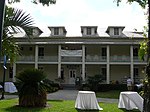Fort Lauderdale Fire-Rescue Department
Commons link is the pagenameFire departments in FloridaOrganizations based in Fort Lauderdale, Florida

Fort Lauderdale Fire-Rescue Department is the fire and rescue service provider for the City of Fort Lauderdale, Florida, as well as the cities of Wilton Manors and Lazy Lake through service contracts. Additionally the FLFRD is responsible for ARFF at Fort Lauderdale Executive Airport. In 2013, the department responded to 44,387 calls for service.
Excerpt from the Wikipedia article Fort Lauderdale Fire-Rescue Department (License: CC BY-SA 3.0, Authors, Images).Fort Lauderdale Fire-Rescue Department
Northwest 6th Avenue, Fort Lauderdale
Geographical coordinates (GPS) Address Nearby Places Show on map
Geographical coordinates (GPS)
| Latitude | Longitude |
|---|---|
| N 26.133333333333 ° | E -80.15 ° |
Address
Northwest 6th Avenue 809
33311 Fort Lauderdale
Florida, United States
Open on Google Maps







